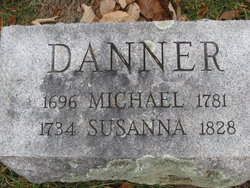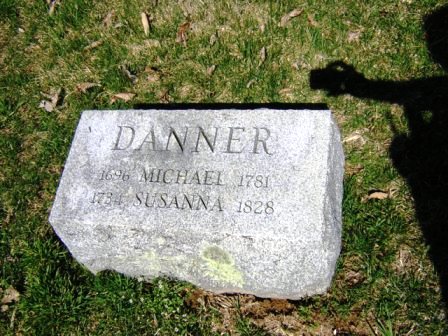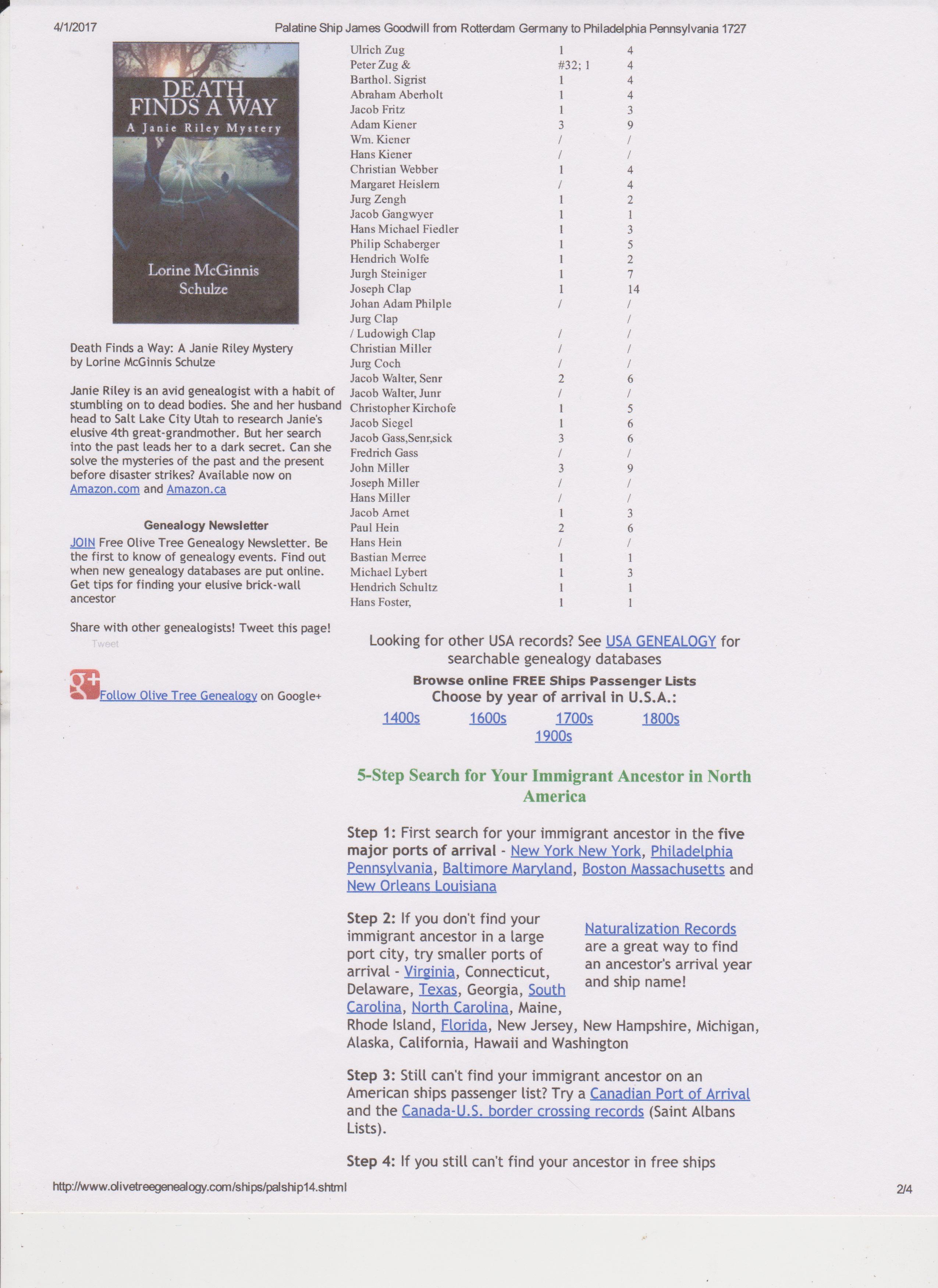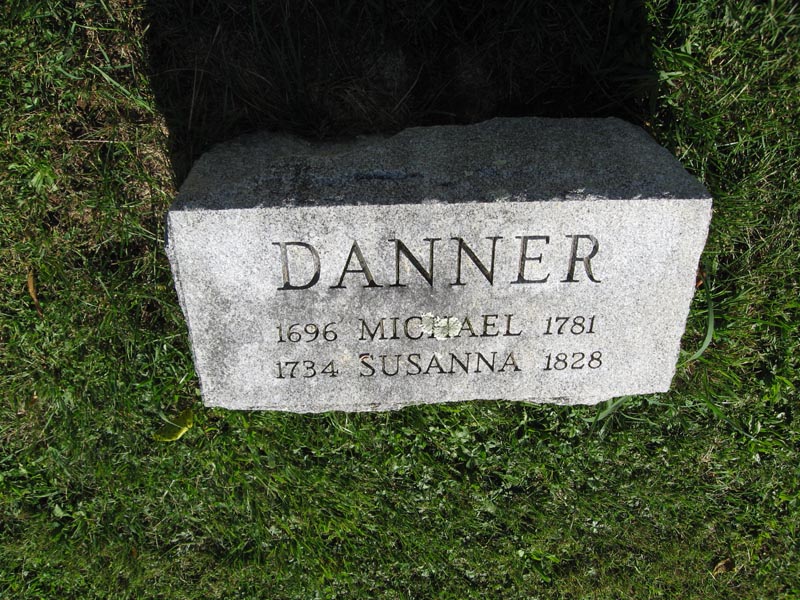Later, in 1727 he moved to the Pequea Settlement of Lancaster County
according to article in "Brethren Roots and Branches", Vol 3, Dec1981. Some
confusion exists because the " Mennonite Encylopedia" refers to Michael Danner
as "an early member of the Mellinger Mennonmite congregation of Lancaster
County" and suggests he crossed the river ( Susquehanna) by 1719.
In 1728, the Indians appealed to Governor Gordon to have certain settlers
removed from the lands west of the Susquehanna River. Among them was Michael
Danner. He was considered an intruder on lands which the Indians had not yet
released to the white settlers. The authorities duly removed them. Refer to
"History of York County, PA" by Rupp, pg. 347.
In 1732, Samuel Blunston, land agent for the Penn's, wrote to the Governor
about some men arrested by associates of Col. Thomas Cresaps of Maryland and
taken to Annapolis. Included was Michael Danner. Although Gov. Samuel Ogle of
Maryland later argued that the German settlers west of the Susquehanna had not
been granted patents, at least 50 of these families had agreed to claim land
under Maryland jurisdiction by 1736. A letter signed by 50 Germans renouncing
their Maryland affiliation dated August 11, 1736 infers this. ( Michael Tanner
et al). See Archives of Maryland 28:100-101. Until 1736, most of the Germans
who crossed the Susquehanna River were only too willing to accept Maryland
jurisdiction.
In 1732, the tax collector reported at least 400 persons living west of the
river who paid taxes to Lancaster County ( History of Pa, W.H. Egle, 1876, pg.
1169).
On 17 Sep 1734, Michael Danner received from Samuel Blunston, land agent of
the Penn's in Columbia, PA, a license to settle 200 acres on the west side if
the Susquehanna River about six miles southwest of John Hendricks ( Quaker of
Wrightsville). This would be somewhere near Mt. Pisgah or Canadochly Church
in what later became Lower Windsor Twp.
In 1736, Michael Danner apparently was arrested a second time by Maryland
authorities. Records of the Sheriff of Anna Arundel County of 4 Jan 1736
mention taking prisoner, Michael Tanner of Baltimore County, for having driven
some fellows from his home in Pennsylvania.
In August 1739 he was one of the six Commissioners named to lay out a road
from Wrightsville to the home of Adam Forney at Digges Choice and later
Hanover. The road extended by way of Kitzmiller's Mill to the Province line
and was known as "Monocacy Road".
Some claim that originally the family was Mennonite, but Gleim thought not.
Michael Danner is listed as the first leader of the German Baptists
(Dunkard's) west of the Susquehanna. In 1770, Danner is listed as a member of
the Conewago Congregation (Black Rock Church of the Brethren).
At one time, Michael Danner owned about 290 acres of land in the vicinity
of Porter's Siding in Heidelberg Twp. The Tax Lists of Hanover and Heidelberg
Twp. for 1778-80 include Michael Danner. Heidelberg Twp. created in 1750 from
northern portion of Manheim Twp.
" Was Michael Danner a Mennonite?", is a six page article in the Dec 1981
Brethren Roots and Branches, quarterly publication of the Brethren
Genealogists of Southern PA, 2490 Middle St., York, PA 17404. Article suggests
that he was a German Baptist with Mennonite neighbors. The article reports
that he was an aggressive, enterprising German who was exceptional both in
character and in his abilities. He spoke both English and German. The book,
History and Families of the Black Rock Church of the Brethren, by Elmer Q.
Gleim has numerous references to him and indicates he was of the Brethren
faith.
An Act of August, 1749, in the Provincial Council of Philadelphia named six
men "to view and lay off a new County ( York). Danner was among them. In 1755
he was appointed as one of " His Majesty's Justices of the Peace",( History of
York County, Prowell).
Aplication of Henry Danner filed in Orphans Court, York County during May
1782 for probate of his father's estate lists his widow , Anna and his
children: Jacob, Catharine, Anna, Michael, Henry, Mary, Phillip and Elizabeth.
(Probate Book F-15).
In 1728 settled at Cabin Creek mouth on Susquehanna River. he got into a dispute
over land. When arrested by Maryland civil authorities
placed in prison in Annapolis. After his release became permanent settler of
York County ( PA Ger. Soc. Vol. 24 & 25, pg. 57). Tanner ( Danner), with a
number of Mennonites from Lancaster Co. settled in the rich farming lands of
the Conewago Valley near "Digg's Choice" on the banks of the Codorus,
Heidelberg Twp. in 1738. This colony of Mennonites was the nucleus of Bair's
Hanover Church. Names of other settlers here were: Hershey, Brubaker, Bair
(Bare), Kauffman, Frantz, Shank, Garber, Bechtel, Bauman, Thoman, Rudisill).
Danner spoke both German and English. Appointed County Commissioner in 1749
to help lay out York County.
Bair's Hanover was first Mennonite congregation in York County to erect a
church ( 3.5 east of Hanover on Hanover- Spring Grove Road). First structure
was of logs ( 1746). Peter Blasser was first known ordained Mennonite minister
in the Michael Danner settlement. He had arrived in 1739 and had been a
Mennonite prisoner from Trachselwald in Berne. Later his children settled near
Stony-Man near Blue Ridge, VA. Adam Forney had settled there earlier ( 1730).
Later, in 1727 he moved to the Pequea Settlement of Lancaster County
according to article in "Brethren Roots and Branches", Vol 3, Dec1981. Some
confusion exists because the " Mennonite Encylopedia" refers to Michael Danner
as "an early member of the Mellinger Mennonmite congregation of Lancaster
County" and suggests he crossed the river ( Susquehanna) by 1719.
In 1728, the Indians appealed to Governor Gordon to have certain settlers
removed from the lands west of the Susquehanna River. Among them was Michael
Danner. He was considered an intruder on lands which the Indians had not yet
released to the white settlers. The authorities duly removed them. Refer to
"History of York County, PA" by Rupp, pg. 347.
In 1732, Samuel Blunston, land agent for the Penn's, wrote to the Governor
about some men arrested by associates of Col. Thomas Cresaps of Maryland and
taken to Annapolis. Included was Michael Danner. Although Gov. Samuel Ogle of
Maryland later argued that the German settlers west of the Susquehanna had not
been granted patents, at least 50 of these families had agreed to claim land
under Maryland jurisdiction by 1736. A letter signed by 50 Germans renouncing
their Maryland affiliation dated August 11, 1736 infers this. ( Michael Tanner
et al). See Archives of Maryland 28:100-101. Until 1736, most of the Germans
who crossed the Susquehanna River were only too willing to accept Maryland
jurisdiction.
In 1732, the tax collector reported at least 400 persons living west of the
river who paid taxes to Lancaster County ( History of Pa, W.H. Egle, 1876, pg.
1169).
On 17 Sep 1734, Michael Danner received from Samuel Blunston, land agent of
the Penn's in Columbia, PA, a license to settle 200 acres on the west side if
the Susquehanna River about six miles southwest of John Hendricks ( Quaker of
Wrightsville). This would be somewhere near Mt. Pisgah or Canadochly Church
in what later became Lower Windsor Twp.
In 1736, Michael Danner apparently was arrested a second time by Maryland
authorities. Records of the Sheriff of Anna Arundel County of 4 Jan 1736
mention taking prisoner, Michael Tanner of Baltimore County, for having driven
some fellows from his home in Pennsylvania.
In August 1739 he was one of the six Commissioners named to lay out a road
from Wrightsville to the home of Adam Forney at Digges Choice and later
Hanover. The road extended by way of Kitzmiller's Mill to the Province line
and was known as "Monocacy Road".
Some claim that originally the family was Mennonite, but Gleim thought not.
Michael Danner is listed as the first leader of the German Baptists
(Dunkard's) west of the Susquehanna. In 1770, Danner is listed as a member of
the Conewago Congregation (Black Rock Church of the Brethren).
At one time, Michael Danner owned about 290 acres of land in the vicinity
of Porter's Siding in Heidelberg Twp. The Tax Lists of Hanover and Heidelberg
Twp. for 1778-80 include Michael Danner. Heidelberg Twp. created in 1750 from
northern portion of Manheim Twp.
" Was Michael Danner a Mennonite?", is a six page article in the Dec 1981
Brethren Roots and Branches, quarterly publication of the Brethren
Genealogists of Southern PA, 2490 Middle St., York, PA 17404. Article suggests
that he was a German Baptist with Mennonite neighbors. The article reports
that he was an aggressive, enterprising German who was exceptional both in
character and in his abilities. He spoke both English and German. The book,
History and Families of the Black Rock Church of the Brethren, by Elmer Q.
Gleim has numerous references to him and indicates he was of the Brethren
faith.
An Act of August, 1749, in the Provincial Council of Philadelphia named six
men "to view and lay off a new County ( York). Danner was among them. In 1755
he was appointed as one of " His Majesty's Justices of the Peace",( History of
York County, Prowell).
Aplication of Henry Danner filed in Orphans Court, York County during May
1782 for probate of his father's estate lists his widow , Anna and his
children: Jacob, Catharine, Anna, Michael, Henry, Mary, Phillip and Elizabeth.
(Probate Book F-15).
In 1728 settled at Cabin Creek mouth on Susquehanna River. he got into a dispute
over land. When arrested by Maryland civil authorities
placed in prison in Annapolis. After his release became permanent settler of
York County ( PA Ger. Soc. Vol. 24 & 25, pg. 57). Tanner ( Danner), with a
number of Mennonites from Lancaster Co. settled in the rich farming lands of
the Conewago Valley near "Digg's Choice" on the banks of the Codorus,
Heidelberg Twp. in 1738. This colony of Mennonites was the nucleus of Bair's
Hanover Church. Names of other settlers here were: Hershey, Brubaker, Bair
(Bare), Kauffman, Frantz, Shank, Garber, Bechtel, Bauman, Thoman, Rudisill).
Danner spoke both German and English. Appointed County Commissioner in 1749
to help lay out York County.
Bair's Hanover was first Mennonite congregation in York County to erect a
church ( 3.5 east of Hanover on Hanover- Spring Grove Road). First structure
was of logs ( 1746). Peter Blasser was first known ordained Mennonite minister
in the Michael Danner settlement. He had arrived in 1739 and had been a
Mennonite prisoner from Trachselwald in Berne. Later his children settled near
Stony-Man near Blue Ridge, VA. Adam Forney had settled there earlier ( 1730).
Inscription
DANNER
Family Members
Advertisement
Records on Ancestry
Sponsored by Ancestry
Advertisement










